Date : July 30 - 31, 2019
Notice: Iwate Press Tour
post date : 2019.07.05
 Topics:
Topics:
(1) Kamaishi’s Hopes for the Rugby World Cup
(2) Beyond Reconstruction: Efforts by Youths, Women, and “Outsiders”
Kamaishi, Iwate is the only venue for the Rugby World Cup starting in Japan in September this year to have been badly damaged in the Great East Japan Earthquake. Over one thousand people were lost to tsunami in Kamaishi, and when it announced its bid as a venue in 2014 many residents were still living in temporary housing, leading to criticism from some corners that “Reconstruction is more important than the World Cup.” There are only two months left until the first Rugby World Cup match in Kamaishi. How will hosting the Rugby World Cup benefit an area struck by disaster, and what are people’s thoughts as they prepare to host the event? With the 2020 Olympic and Paralympic Games in Tokyo using the theme of “Reconstruction Olympics,” this tour will look at the role sports can play in reconstruction.
The disaster-affected areas were also suffering from the same issues as other regions in Japan before the earthquake, such as population decline, an aging population, and the hollowing-out of industry, and the disaster only exacerbated these issues. The disaster-affected areas in Tohoku are a microcosm of the issues facing Japan. “There is no future in a reconstruction returning things to how they were. This crisis should be turned into an opportunity.” Along Iwate’s Sanriku Coast, initiatives to solve preexisting problems in the region are becoming successful, renewing the region and creating new industries. Central roles have been played in these initiatives by youths, women, and “outsiders” who stepped up after the disaster. There is only one and a half years left until the end of the “reconstruction period” set by the Japanese government. This tour will look at people who are working to make a new Tohoku that can be a model for other regions in Japan facing similar issues, as reconstruction demand declines.
[Tour Details]
1. Kamaishi
-The only Rugby World Cup venue in Tohoku. A small town’s big challenge.
Over one thousand Kamaishi residents died or went missing in the tsunami during the Great East Japan Earthquake, of its population at the time of 40,000. The reason Kamaishi was chosen as a venue for the Rugby World Cup is because it is historically a rugby town, home to the Nippon Steel Corporation Kamaishi rugby team which won the Japanese championship seven years in a row, from 1979 to 1985.
Former members of the Nippon Steel Corporation Kamaishi rugby team were the first to suggest that the Rugby World Cup could help with reconstruction in Kamaishi. Encouragement from both within Japan and around the world inspired the residents who at first thought making a bid for the Rugby World Cup was unrealistic. Local volunteers began to work towards a bid, and in July 2014 the city officially announced its bid to be a host city for the Rugby World Cup. In March 2015, Kamaishi was selected as one of the 12 host cities in Japan, and the only one from Tohoku and affected by the Great East Japan Earthquake.
At its peak in the 1960s, Kamaishi had a population of over 90,000, and in the 50 years since it declined by 60%. It is predicted to decline by nearly another 40% by 2040. Having faced problems including population decline and a “hollowing out” of industry even before the disaster, since the disaster Kamaishi has been working on making a more sustainable city focusing on the connections between people, under the concept of an “open city.” Examples include a program to support people relocating from big cities to start businesses in Kamaishi, and the first case in Japan of a collaboration with Airbnb. Plans are to have people stay in private residences to help respond to the temporary demand for accommodation during the Rugby World Cup.
The tour will visit the Kamaishi City Office, and hear from Deputy Mayor Hideki Yamazaki about local feelings on hosting the Rugby World Cup, and future plans for a sustainable city after the Rugby World Cup and reconstruction.
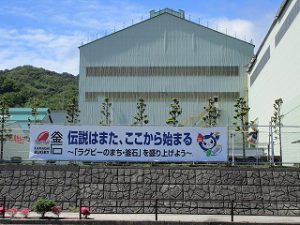

2. Kamaishi Unosumai Memorial Stadium
-A symbol for the recovery of Kamaishi and to pass on the lessons of the disaster
In the Unosumai district located in northern Kamaishi, a total of 580 people died or went missing in the tsunami. This is almost 60% of the total losses Kamaishi suffered. The students at the two schools in this area, Kamaishi East Junior High School and Unosumai Elementary School, worked together to evacuate to higher ground on their own after the earthquake hit. This evacuation became known throughout the world as the “Miracle of Kamaishi,” the result of years of disaster-prevention education of the students. At the same time, over 160 residents lost their lives at the Unosumai Disaster Prevention Center across the river from the schools, as people assumed it was a tsunami evacuation site.
Kamaishi’s stadium, the only new facility among the venues for Japan’s Rugby World Cup, was built on the former grounds of Kamaishi East Junior High School and Unosumai Elementary School, which became the stage for the “Miracle of Kamaishi.” Called “a symbol for the recovery of Kamaishi,” it has become a vessel for the feelings of residents. There is a memorial by the stadium with “Please run” written on it, so that the people who come to watch the Rugby World Cup will be able to learn the lessons of the disaster.
In order to keep down construction costs, as reconstruction is still underway, the permanent stands have 6,000 seats. Even with the 10,000 temporary seats installed for the Rugby World Cup, it will be the smallest of the 12 stadiums. The temporary stands will be removed after the Fiji-Uruguay (September 25) and Namibia-Canada (October 13) matches are finished.
Mr. Takeshi Nagata (36), a fixed-term employee of Kamaishi City working to prepare for the Rugby World Cup, is a former player and coach for the Kamaishi Seawaves, the successors to Nippon Steel Corporation Kamaishi. After the disaster, Mr. Nagata and the other players and staff members of the Seawaves volunteered to distribute supplies and for other activities, despite having been affected by the disaster themselves. According to Mr. Nagata, “Kamaishi is a rugby town. The bid for the Rugby World Cup helped shine a light of hope for the future when Kamaishi was going through tough times. By showing everyone being excited by rugby, I hope to thank everyone around the world who supported us after the disaster by showing them how lively Kamaishi has become thanks to them. That is what this Rugby World Cup means to the people of Kamaishi.”
The tour will visit the Kamaishi Unosumai Memorial Stadium and hear from Mr. Nagata about local preparations for the Rugby World Cup, and feelings about hosting it in Kamaishi. The tour will then look around the stadium.
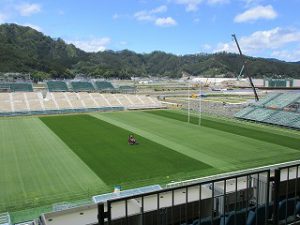
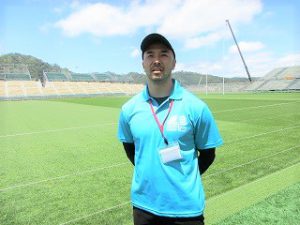
3. Inochi o Tsunagu Miraikan: A Facility to Tell the Story of the Tsunami
-Youth who experienced the Miracle of Kamaishi tell her story of that day
In March 2019, the Inochi o Tsunagu Miraikan, a facility to tell the story of the tsunami, opened by Unosumai Station, a ten-minute walk from the Kamaishi Unosumai Memorial Stadium. The facility was built by Kamaishi City as a center for learning about disaster prevention by passing on the history and lessons of the disaster. Its exhibits show what happened in Kamaishi that day, and what disaster-prevention education the children of Kamaishi engaged in.
Ms. Nodoka Kikuchi (23) works as a storyteller at the facility, and experienced the “Miracle of Kamaishi” evacuation as a third-year student at Kamaishi East Junior High School. She returned to Kamaishi, where she was born and raised, after graduating from university this spring. Ms. Kikuchi explains to visitors from Japan and around the world about the disaster-prevention education in Kamaishi which she experienced herself before the disaster, and about all the students running away together from the approaching tsunami.
With only two months left until the Rugby World Cup, Ms. Kikuchi commented, “As someone who attended the school that used to be where the stadium now is, I hope the Rugby World Cup will provide an opportunity for the people of the world to learn what happened in this town at the time of the disaster.”
Ms. Kikuchi will guide the tour around the Inochi o Tsunagu Miraikan, and the tour will visit the Kamaishi Inori no [Prayer] Park built where the Unosumai Disaster Prevention Center used to be located, where over 160 people died.

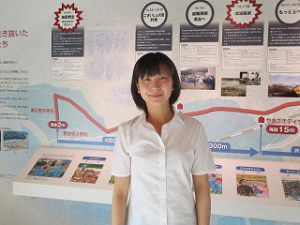
4. Nebama Beach in Unosumai
-A ryokan okami and a woman relocatee working on developing a sustainable community
Before the disaster, Nebama Beach in Unosumai was known as one of the Sanriku Coast’s most photogenic spots, due to its white sand beach and beautiful pine trees, and had over 40,000 visitors annually. But due to the tsunami and land subsidence, the beach was mostly obliterated.
The tsunami reached the second floor of Horaikan, a ryokan [traditional inn] located on Nebama Beach, and although the okami [woman manager], Ms. Akiko Iwasaki (63), was swallowed by the tsunami at one point, she survived. Ms. Iwasaki started rebuilding the ryokan and speaking about her experiences in the disaster immediately afterwards, while working to revitalize the area. When people involved with rugby suggested making a bid to be a Rugby World Cup venue, Ms. Iwasaki was one of the first to agree, saying “we want hope and a goal,” and made a significant contribution to the Kamaishi bid.
Taking advantage of the beautiful ocean and nature there, Nebama was home to ecotourism before the disaster. After the disaster, through discussions with residents, it was decided to rebuild a seawall of a height that allowed the ocean to be seen, like before the disaster. Ms. Iwasaki wants to make Nebama into a place that people from around the world visit, using local resources such as its beautiful nature.
Working as Ms. Iwasaki’s partner is Ms. Eri Hosoe (32), from Tokyo. She quit her job in Tokyo after the disaster to help with reconstruction in Iwate, and in June 2017 moved to Nebama as one of the first participants in Kamaishi’s system to support relocatees starting new businesses. Ms. Hosoe’s goal is to polish up the existing local resources of Nebama and create a cycle where people and money come into the area from the outside. With her perspective as an “outsider” who has relocated to the area, she is working on developing programs and experiences that will entice people from outside the area to come to Nebama, and on spreading information domestically and internationally. She has focused on the aspect of Nebama as a place of learning, one of its local resources. Ms. Hosoe is working on a plan to have people from around the world visit Nebama, to learn about its experiences with disaster and reconstruction and share knowledge about disaster prevention.
The tour will visit Horaikan and hear from Ms. Iwasaki about her feelings on hosting the Rugby World Cup and working towards revitalizing Nebama. Ms. Hosoe will speak about moving to Kamaishi and her future business plans. The tour will then go to Nebama Beach and see the progress being made on its reconstruction.
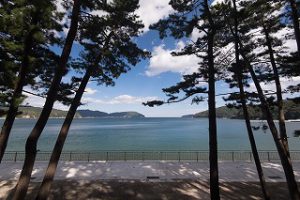
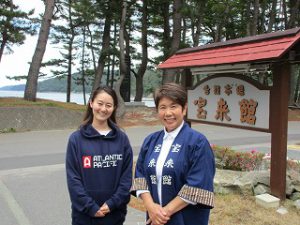
5. Kyowa Fishery Co., Ltd.
-A young leader calling himself the “Squid Prince” promoting the fishery industry in the Sanriku region
Kyowa Fishery is a seafood processing company that makes processed food products out of catches brought in at the Port of Miyako. Their biggest product is ika somen [squid noodles], which they also export overseas to places such as Taiwan and the US, with sales having increased from 300 million yen before the disaster to nearly 800 million yen.
This growing company is managed by Mr. Ryota Suzuki (37). He was working “without any real dedication” at Kyowa Fishery, the company his father founded, but his attitude changed after the Great East Japan Earthquake. Seeing the damage which had been inflicted on the town and fishery industry in Miyako, he felt inspired to do something to help the town and do what was possible to help as a business. He decided to help stimulate the fishery industry in Miyako, calling himself the “Squid Prince” and playing a leading role in product development and expanding sales routes. Wearing an original crown and T-shirt, the Squid Prince travels both in Japan and overseas to promote “Made in Sanriku” products, and has received media attention for his efforts.
Since 2017, Mr. Suzuki has also been working together with other young businesspeople from different industries in Miyako to develop new products and build Miyako’s seafood products brand. One of these products, fried cod made with Pacific cod the same day it is brought in at the Port of Miyako, became popular across Japan, and there is now a one to two month waiting period for online orders. There are plans in place to have rugby fans from around the world enjoy this fried cod as fish and chips at Kamaishi’s Rugby World Cup venue.
Mr. Suzuki commented, “The fishery industry is the core industry of Miyako. I would like to show the attraction of the fishery industry by letting children and young people in the area see that someone my age is having fun working.”
The tour will visit the processing plant that was newly built in 2014, and hear from Mr. Suzuki about invigorating Miyako through food and promoting Sanriku seafood world, as well as seeing the plant.
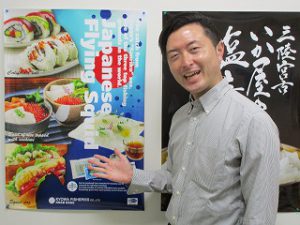

6. Corporate Impact Co., Ltd.
-A woman president of an IT business in Tokyo contributing to the reconstruction of her hometown Otsuchi
In the tsunami caused by the Great East Japan Earthquake, 1277 people from Otsuchi died or went missing, equivalent to about one tenth of its population. “Starting a business in the town is the only way to invigorate it.” Born in Otsuchi and running a business in Tokyo that digitalizes analog content, Ms. Kumiko Fukuda (55) transferred part of her company’s work to Otsuchi after the disaster to create employment in the IT sector. With the motto of “creating employment with a single red pen,” she started with proofreading jobs that could be done at home even without a computer, and was met with gratitude by people affected by the disaster who could not leave their home to work due to having to take care of children or elderly parents.
In May 2017, the Otsuchi Information Technology Center of Corporate Impact Co., Ltd., a company which Ms. Fukuda is involved in operating, was built in the center of Otsuchi. It is a three-floor IT building with a biometric fingerprint door lock system. Inside, approximately 10 local hires look at their computer screens to proofread and check scanned data sent from Tokyo of documents from government agencies or other clients. There are also approximately 20 employees from Otsuchi and the Sanriku Coast who telecommute.
Ms. Fukuda went to Tokyo as soon as she graduated from high school, and from her perspective in Tokyo she felt, “At this rate Otsuchi will be one of the municipalities that disappears.” According to Ms. Fukuda, “Although the area was hit by disaster, jobs with employment itself as the goal have no future. It is important to develop a competitive industry with competitive workers. I want to find even more workers and turn Otsuchi into an IT service hub.”
Ms. Fukuda is also contributing to the recovery of the Sanriku fishery industry. Her father was a fisher, and she wanted people to taste the delicious fish of Otsuchi, so she opened a seafood restaurant in Tokyo. After the disaster, one of the companies she is involved in received the grand prize in the Revive Japan Cup business contest held by the Reconstruction Agency, with a system to transport fish from Otsuchi to Tokyo using standard delivery instead of freezer trucks, keeping the fish fresh with high-tech refrigerants. Currently, she is using her perspective as a member of the IT sector to support the incorporation of ICT into the fishery industry.
The tour will visit the Otsuchi Information Technology Center and hear from Ms. Fukuda about her efforts to support the recovery of her hometown of Otsuchi, and see the office where proofreading and checking is being carried out.
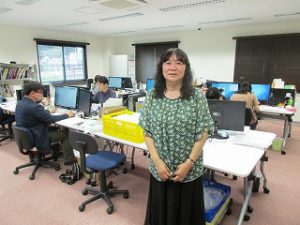
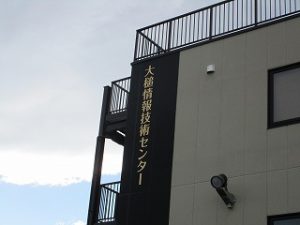
7. Otsuchi High School Reconstruction Club
-High school students passing on the story of reconstruction and the lessons of the disaster to the future
Many local residents evacuated to Iwate Prefectural Otsuchi High School, located on high ground in Otsuchi, immediately after the disaster. The school was used as an evacuation shelter for about five months, with nearly 1000 people living there at its peak, and the students and teachers helping to run the shelter.
Based on this experience, in 2013 the Otsuchi High School Reconstruction Club was formed. Currently, about 70% of the 160 students at the school are involved in activities with one of the club’s five teams, such as “fixed-point observation” or “community building.” The fixed-point observation team takes pictures at the same angle from the same point in 180 locations around the town. Taking pictures three times a year since 2013, the over 3,000 pictures record the changing face of the town as reconstruction progresses.
These high school students were in the lower grades of elementary school when the disaster occurred, but at some point the school’s students will not remember or not have experienced the disaster. Based on their belief that their memories of the tsunami and the lessons from the disaster must be passed on, some volunteers from the club made a kamishibai [paper play] to communicate the dangers of tsunami. As the reconstruction of the town progresses, there are discussions within the school about what activities the Reconstruction Club should carry out in the future, but disaster prevention will remain one of their main pillars.
The tour will visit the new Oshacchi community center in central Otsuchi, and hear from the students about their activities before a demonstration of their fixed-point observation in the town.
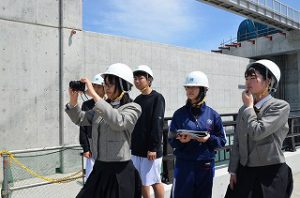
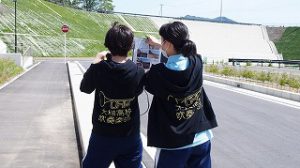
Photos provided by Otsuchi High School Reconstruction Club
[Tour Itinerary]
1. Schedule
*The schedule is not yet finalized, and may change without notice.
<Day 1: July 30 (Tue)>
7:16-9:49 Tokyo Station - Shin-Hanamaki Station (Hayabusa #101)
11:30-12: 15 Inochi o Tsunagu Miraikan
12:30-13:30 Kamaishi Unosumai Memorial Stadium
13:45-14:30 Lunch @Horaikan
14:30-16:00 Nebama Beach
16:30-17:30 Deputy Mayor of Kamaishi
17:45 Arrive at hotel
<Day 2: July 31 (Wed)>
7:30 Leave hotel
9:15-9:45 Sanriku Railway Co,.Ltd.
10:10-11:40 Kyowa Fishery Co., Ltd.
12:30-13:15 Lunch
13:30-14:45 Corporate Impact Co., Ltd.
15:00-16:15 Otsuchi High School Reconstruction Club
18:06-21:12 Shin-Hanamaki Station - Tokyo Station (Yamabiko #54)
2. Qualification: Bearer of Gaimusho Press Registration Card
3. Cost: 14,000 Yen per person including transportation, accommodation and lunches
*Information on payment and cancellation fee will be provided to participants.
4. Participants: Limited to 10 applicants.
(Only one reporter or one photographer from each company, but two participants from each TV team will be acceptable.)
*If the number of applicants exceeds 10, an upper limit may be set on the number of participants from each country/region.
5. FPCJ Contact: Junya Sugawara and Mayuko Onishi (Tel: 03-3501-3405、E-mail: ma@fpcjpn.or.jp)
6. Remarks:
(1) This tour is organized by the Sanriku Disaster Prevention and Recovery Project 2019 Executive Committee and planned and operated by the FPCJ.
(2) The schedule is subject to change without notice.
(3) This tour will require participants to bear part of the cost, but is not a profit-making venture.
(4) Neither the organizer nor FPCJ will be liable for any inconvenience, trouble or accidents that might occur during the tour.
(5) There may be some restrictions on photographing and filming at the tour sites. Please follow the instructions of the staff in charge.



